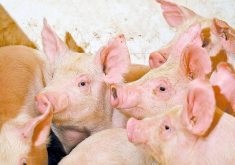Eight cattle herds in eastern Manitoba are under federal quarantine in what may mean a temporary end to Canada’s status as free of anaplasmosis, the Manitoba Co-operator reported May 14.
Dr. Lynn Bates, a veterinary program officer with the Canadian Food Inspection Agency (CFIA) in Winnipeg, said the herds are in an area west of the Winnipeg River in the rural municipalities of Lac du Bonnet and Alexander.
Within the eight herds are a total of 305 infected cattle, or “reactors,” detected through a periodically conducted national bovine serological survey, Bates said.
Read Also

Horns aren’t unlocking anytime soon on livestock transport standards
Standards good enough meet the definition of “humane” animal transportation still vary widely between what what industry wants, what animal rights advocates want and, between the two, what federal regulators decide is good enough.
Anaplasmosis is a reportable livestock disease in Canada, caused by a parasite of red blood cells. It affects domestic and wild ruminants but only cattle show clinical signs.
The disease can be transmitted in infected red blood cells by biting insects and through contaminated instruments such as hypodermic needles and dehorning equipment.
Since anaplasmosis is blood-borne and it’s not possible to avoid insects, changing needles frequently and disinfecting dehorning equipment in between use are the best ways to limit exposure to the disease, said Dr. Wayne Lees, Manitoba’s chief veterinarian.
The cause of the outbreak is not certain but the disease was most likely brought into the area by infected livestock imported from the U.S., Bates said.
Anaplasmosis, endemic in much of the lower continental U.S., is not a regulated disease in that country but costs the U.S. cattle industry an estimated US$300 million per year.
Canada is considered anaplasmosis-free, but the Manitoba cases, the province’s first since 1970, may change that status. CFIA was obliged to report the case to the World Organization for Animal Health (OIE), Bates said.
Canada until 2004 required anaplasmosis testing of live cattle imported from the U.S. during the biting insect season. But new rules in 2004 allowed U.S. feeder cattle from 39 states considered “low-risk” for the disease into Canada without testing at any time of year.














